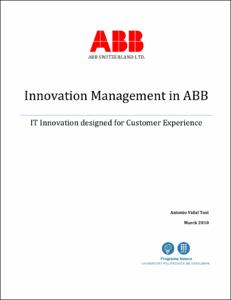Innovation Management in ABB - IT Innovation designed for Customer Experience

Visualitza/Obre
Estadístiques de LA Referencia / Recolecta
Inclou dades d'ús des de 2022
Cita com:
hdl:2099.1/9384
Tipus de documentProjecte/Treball Final de Carrera
Data2010
Condicions d'accésAccés obert
Llevat que s'hi indiqui el contrari, els
continguts d'aquesta obra estan subjectes a la llicència de Creative Commons
:
Reconeixement-NoComercial-SenseObraDerivada 3.0 Espanya
Abstract
This Thesis sets out some foundations for the influence of innovation on the Factory Acceptance Test (FAT) of the Generator Circuit Breaker that is manufactured in ABB Schweiz AG in Zürich-Oerlikon, Switzerland. It is an academic study that came out during a traineeship in the project execution department while improving the FAT process from a marketing point of view, applying innovation to increase the experience of the customers.
The Factory Acceptance Test is made by the manufacturer, ABB Switzerland Ltd, at the factory as part of the process of producing the Generator Circuit Breaker. In the most cases, the customer attends this test in order to certify that the design specifications and manufactured product fit with the requirements.
In usual applications, the principal function of the Generator Circuit Breaker is to carry generator rated load current and provide a means for interruption of short-circuit current from the generator as well as from the power system.
This Thesis has the goal to explain how innovation is carried out in ABB, globally and locally. It consists of five different chapters that are structured based on a top-down approach.
The first chapter presents the theoretical basis of innovation and deepens into Strategic Technology and Innovation Management, IT Innovation and Knowledge Management strategies.
To understand better the work environment as well as the innovation processes in ABB Global and ABB Switzerland Ltd., the second chapter is a research on ABB’s innovation activities. It focuses on the global organization structure and R&D execution and explains the optimizations done in the production process of the Generator Circuit Breaker and its influence on the FAT process.
Due to the change from a traditional to a Lean based assembly, the FAT process required adapting. These requirements as well as the process flow, the agents and goals are presented in the third chapter. This chapter will set up the object of the study and frame all the later actions, taking into account that it is a process where customers play a main role, as they have to witness and accept the results of the tests.
The fourth chapter focuses on the innovative improvements applied to the FAT. The utilization of the Remote Factory Acceptance Test (RFAT) System and the creation of a Lotus Notes Database Tool are the basis to improve the whole process from a customer oriented point of view. These actions are explained considering the theory of innovation of the first chapter, the organizational environment of the second one and the FAT process defined in the third chapter.
The last chapter presents the conclusions regarding the impact of the improvements, and evaluates possible reutilization scenarios for both tools.
Descripció
Projecte final de carrera realizat en col.laboració amb ABB Switzerland
MatèriesInformation technology, Innovacions tecnològiques -- Direcció i administració, Tecnologia de la informació
TitulacióENGINYERIA DE TELECOMUNICACIÓ (Pla 1992)
| Fitxers | Descripció | Mida | Format | Visualitza |
|---|---|---|---|---|
| PFC Antoni Vidal ABB-INNOVA'TICs.pdf | 4,453Mb | Visualitza/Obre |


